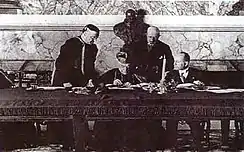Fascisme clérical
Le fascisme clérical (cléro-fascisme, clérico-fascisme) est un terme apparu dans les années 1920, pour désigner les relations entre le fascisme italien et l'Église[1].

Il désigne une idéologie mêlant la doctrine économique et politique du fascisme à la théologie ou aux traditions religieuses. Plusieurs organisations et mouvements ont été qualifiés de « fascistes-cléricaux », notamment des associations religieuses apportant leur soutien au fascisme, mais également des régimes fascistes faisant jouer un rôle important au clergé (Getúlio Vargas, António de Oliveira Salazar…). Le cléricalisme n'est cependant pas l'apanage des fascismes : Napoléon Bonaparte affirmait que « Les conquérants habiles ne sont jamais brouillés avec les prêtres »[2].
Description
Au début des années 1980, le terme d'« intégralisme » a parfois été utilisé comme synonyme de « fascisme clérical » par des universitaires comme Hugh Trevor-Roper, dans le cadre d'une construction d'une typologie du fascisme, faisant la distinction entre le fascisme clérical et des types de fascismes laïcs comme le nazisme ou le hungarisme[3].
Groupes fascistes cléricaux
- La Phalange espagnole et les partis héritiers du Phalangisme espagnol.
- Les juntes militaires de l'Amérique latine et les escadrons de la mort financés par les grands planteurs de ces pays, comme par exemple la « Révolution libératrice » et la « Révolution argentine » ou bien les régimes militaires chilien et brésilien ; beaucoup de leurs meneurs étaient issus de issues de l'École militaire des Amériques.
- Les Chrétiens allemands et le Christianisme positif prôné par les nazis.
- Le Front patriotique autrichien, qui prônait un nationalisme autrichien (opposé au Pangermanisme) et un national-catholicisme.
- La British Union of Fascists prônait la tolérance religieuse entre catholiques et protestants.
- Même chose pour le régime de Miklós Horthy en Hongrie.
- Le parti égyptien Jeune Égypte, qui était un parti fasciste et islamiste lors de l'entre-deux-guerres.
- La Milice française du Régime de Vichy.
- En Roumanie, la Garde de fer et plus récemment la Nouvelle droite qui prônent un nationalisme mêlé de christianisme orthodoxe intégriste.
- Le Régime du 4-Août de Ioánnis Metaxás en Grèce et son mouvement était fortement pour le cléricalisme.
- Le ZBOR, mouvement fasciste et yougoslaviste qui prônait un nationalisme chrétien orthodoxe, puis Action serbe[4] en Serbie indépendante depuis 2010.
- Les Oustachis prônaient un nationalisme ethnique croate et catholique. Ils ont notamment forcé des civils non catholiques à se convertir.
- Le Camp national-radical en Pologne qui voit dans le catholicisme un objectif suprême.
Notes et références
- (en) Cet article est partiellement ou en totalité issu de l’article de Wikipédia en anglais intitulé « Clerical fascism » (voir la liste des auteurs).
- (en) Reflections on Fascism and Religion
- Napoléon Bonaparte (1769-1821), « Lettre à Lucien Bonaparte, ambassadeur à Madrid, 18 avril 1801 » in : L'histoire en citations, .
- H. R. Trevor-Roper, « The Phenomenon of Fascism », Fascism in Europe (Londres, Methuen, 1981) de S. Woolf (ed.), particulièrement la p. 26. Évoqué par Roger Eatwell, Reflections on Fascism and Religion
- Dijana Jelaca, Maša Kolanovic, Danijela Lugaric : The Cultural Life of Capitalism in Yugoslavia: (Post)Socialism and Its Other
Voir aussi
Articles connexes
Bibliographie
- Randolph L. Braham (en) et Scott Miller, The Nazis Last Victims: The Holocaust in Hungary (Detroit: Wayne State University Press, [1998] 2002). (ISBN 0-8143-2737-0)
- Leon Volovici, Nationalist Ideology and Antisemitism: The Case of Romanian Intellectuals in the 1930s (Oxford: Pergamon Press, 1991). (ISBN 0-08-041024-3)
- Nicholas M. Nagy–Talavera, The Green Shirts and the Others: A History of Fascism in Hungary and Romania (Iaşi and Oxford: The Center for Romanian Studies, 2001). (ISBN 973-9432-11-5)
- Charles Bloomberg and Saul Dubow, eds., Christian–Nationalism and the Rise of the Afrikaner Broederbond in South Africa, 1918–48 (Bloomington: Indiana University Press, 1989). (ISBN 0-253-31235-3)
- Walid Phares, Lebanese Christian Nationalism: The Rise and Fall of an Ethnic Resistance (Boulder, Colo.: L. Rienner, 1995). (ISBN 1-55587-535-1)
- Ainslie T. Embree, ‘The Function of the Rashtriya Swayamsevak Sangh: To Define the Hindu Nation’, in Accounting for Fundamentalisms, The Fundamentalism Project 4, ed. Martin E. Marty and R. Scott Appleby (Chicago: The University of Chicago Press, 1994), p. 617–652. (ISBN 0-226-50885-4)
- Partha Banerjee, In the Belly of the Beast: The Hindu Supremacist RSS and BJP of India (Delhi: Ajanta, 1998). (ISBN 81-202-0504-9)
- Walter K. Andersen. ‘Bharatiya Janata Party: Searching for the Hindu Nationalist Face’, In The New Politics of the Right: Neo–Populist Parties and Movements in Established Democracies, ed. Hans–Georg Betz and Stefan Immerfall (New York: St. Martin’s Press, 1998), p. 219–232. (ISBN 0-312-21134-1 et 0-312-21338-7)
- Mark Juergensmeyer. The New Cold War?: Religious Nationalism Confronts the Secular State. (Berkeley: University of California Press, 1993). (ISBN 0-520-08651-1)
- (en)Roger Eatwell "Reflections on Fascism and Religion"
- (en)Chip Berlet Terms to use with caution
- Laqueur, Walter. 1966. Fascism: Past, Present, Future, New York: Oxford: Oxford University Press, 1997. (ISBN 0-19-511793-X)
Conduite du Vatican
- Anthony Rhodes, The Vatican in the Age of Dictators 1922–1945 (London: Hodder and Stoughton, 1973). (ISBN 0-340-02394-5)
- Michael Phayer, The Catholic Church and the Holocaust, 1930–1965 (Bloomington: Indiana University Press, 2000) (ISBN 0-253-33725-9)
- Livia Rothkirchen, ‘Vatican Policy and the ‘Jewish Problem’ in Independent Slovakia (1939–1945)’ in Michael R. Marrus (ed.),The Nazi Holocaust 3, section 8, Bystanders to the Holocaust (Wesport: Meckler, 1989), p. 1306–1332. (ISBN 0-88736-255-9 et 0-88736-256-7)